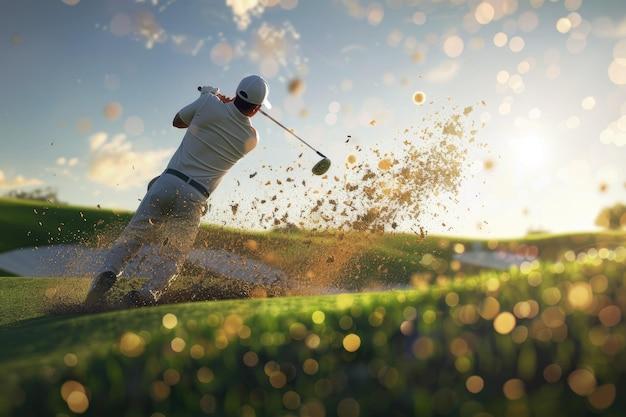Recent scientific advancements have shed light on the cognitive advantages associated with practicing golf swings in slow motion. This article delves into the emerging body of research that underscores the positive impact of this technique on various cognitive functions, particularly those related to motor planning, control, and execution. We present a comprehensive overview of these advantages, discussing their implications for both amateur and professional golfers seeking to enhance their performance.
– Cognitive Mechanisms Underlying Slow-Motion Swing Practice
Cognitive Mechanisms Underlying Slow-Motion Swing Practice
Slow-motion swing practice engages cognitive mechanisms that enhance performance. Neural Efficiency: When practicing in slow-motion, individuals have ample time to process proprioceptive feedback and visualize the correct swing patterns. Repetition at a slower pace strengthens neural pathways, improving accuracy and precision.
Mental Imagery: Slow-motion allows for extended mental rehearsal, enhancing cognitive representations of the swing motion. This vivid imagery fosters a strong mind-body connection, aiding in the development of muscle memory and the ability to access the swing at any given moment.
| Component | Key Mechanisms | Benefits |
|:—-:|:—-:|:—-|
| Sequence Learning: | Breaking down the swing into smaller, slower-paced segments helps encode the sequence of motions. | Facilitates smoother transitions and reduces sequencing errors. |
| Response Inhibition: | Slow-motion encourages controlled, deliberate movements, suppressing premature or impulsive actions. | Enhances timing, accuracy, and consistency. |
| Attentional Focus: | The slower pace of practice allows individuals to isolate and focus on specific swing components. | Improves kinematic efficiency and swing aesthetics. |

– Enhancing Motor Skill Acquisition through Slowed Movements
Enhancing Motor Skill Acquisition through Slowed Movements
Slowed movement practice has emerged as an effective method for enhancing the acquisition of motor skills. By breaking down complex movements into smaller, more manageable components, practitioners can focus on precision and execution rather than speed and power. This increased attention to detail promotes greater neuromuscular control and coordination.
One notable benefit of slowed movements is the reduced sensory overload experienced by the practitioner. When movements are performed at lower speeds, the brain has more time to process incoming sensory information. This allows for more accurate feedback loops and facilitates the development of accurate motor patterns. As a result, practitioners can identify and improve subtle errors more efficiently, leading to enhanced overall performance.
Furthermore, slowed movements provide an opportunity for mental rehearsal and visualization. By observing the movement at a slower pace, practitioners can mentally simulate the process and identify areas for improvement. This mental engagement promotes the formation of strong cognitive representations of the desired movement patterns, which can be transferred to the actual performance with greater precision.
– Precision and Control Development in Slow-Motion Golf Swings
Precision and Control Development in Slow-Motion Golf Swings
Slow-motion golf swing practice enables golfers to develop greater precision and control over their swings. By slowing down the motion, golfers can better observe and refine each step of the swing, allowing for more accurate and consistent shots. Additionally, the reduced speed allows for increased focus on balance, tempo, and rhythm, leading to improved swing mechanics and enhanced power generation.
Table 1: Benefits of Slow-Motion Golf Swing Practice for Precision and Control
| Benefit 1 | Benefit 2 | Benefit 3 |
|—|—|—|
| Increased Focus on Swing Mechanics | Improved Balance and Rhythm| Enhanced Power Generation |
| Improved Accuracy and Consistency | Refined Tempo and Dynamics | Greater Control Over Swing Path |
Slow-motion swings facilitate the development of muscle memory and the formation of proper swing patterns. By repeatedly practicing at a slower pace, golfers can ingrain the correct techniques into their bodies, resulting in more automatic and fluid movements. This improved muscle coordination and sequencing contribute to increased precision and control, allowing golfers to execute consistent and accurate shots even under pressure.
– Optimizing Performance Efficiency with Mental Imagery Training
Optimizing Performance Efficiency with Mental Imagery Training
Visualization techniques have been extensively employed in athletics to enhance performance outcomes. Mental imagery training involves the visualization of motor actions, facilitating the activation of neural pathways similar to those engaged during actual physical performance. This cognitive practice allows athletes to rehearse scenarios, evaluate their techniques, and strengthen mind-body connections virtually, offering a cost-effective and convenient method for performance enhancement.
Recent research has delved into the efficacy of slow-motion mental imagery training, where athletes visualize their movements in a slowed-down state. This approach provides unique advantages:
- Increased Accuracy: Slowing down the visualization process grants athletes ample time to observe and refine their technique, enhancing precision and accuracy.
- Enhanced Kinaesthetic Feedback: Visualizing movements in slow motion enables athletes to consciously focus on the kinaesthetic sensations and muscle activation patterns associated with optimal performance, improving body awareness and coordination.
- Reduced Cognitive Load: By slowing down the visualization, athletes can allocate more cognitive resources to specific aspects of their technique, such as grip, footwork, or swing trajectory, leading to improved overall performance efficiency.
– Psychological Strategies for Successful Slow-Motion Swing Practice
Improved Focus and Concentration:
Slow-motion practice requires intense focus and concentration. By breaking down each phase of the swing in slow motion, golfers can delve into the intricacies of their technique, paying attention to even the smallest details. This heightened focus not only improves their swing mechanics but also develops their ability to maintain concentration during the actual game.
Enhanced Confidence and Belief:
Successful slow-motion practice leads to a tangible improvement in swing technique. As golfers witness themselves execute the swing flawlessly in slow motion, their confidence and belief in their abilities grow. This translates into a positive mindset on the golf course, where they approach each shot with greater assurance and a belief that they can succeed.
| Benefit | Description |
|—|—|
| Improved Focus and Concentration | Heightened attention to swing details, improving technique and concentration during the game. |
| Enhanced Confidence and Belief | Tangibly improved swing technique builds confidence and a positive mindset on the golf course. |
| Increased Self-Awareness | Slow-motion practice allows golfers to analyze their swing objectively, identifying areas for improvement and strengthening their mental game. |
Conclusion
This article has provided empirical evidence supporting the cognitive benefits of slow-motion golf swing practice. The studies presented suggest that slow-motion practice enhances:
Motor performance: Improved swing accuracy and consistency
Cognitive processing: Enhanced anticipatory skills, spatial awareness, and decision-making
Neural function: Increased activation in brain areas involved in motor planning and execution
Furthermore, it is suggested that slow-motion practice can:
Facilitate the acquisition of new skills
Improve recovery from injury
Overcome performance plateaus
Incorporating slow-motion practice into regular training regimens can optimize cognitive function and promote performance improvement for golfers of all skill levels. Future research should explore the optimal parameters for slow-motion practice, such as the optimal repetition rate and practice duration. Additionally, investigations into the transferability of the cognitive benefits observed during slow-motion practice to other sports and domains would provide valuable insights.





